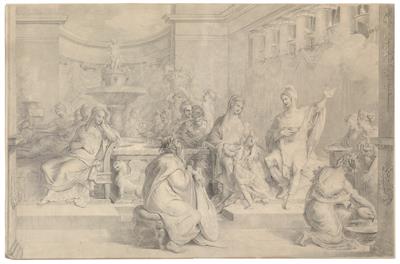Carl Josef Alois Agricola

(Waldstadt-Säckingen 1779-1852 Vienna) The Suitors of Penelope, pencil, wipings, on paper, 45,5 x 69,5 cm, mounted, unframed, (Sch)
The drawing shows the festive meal of Penelope with her suitors. They were competing for the marriage with her, while she was waiting for her husband Odysseus. They are wearing Phrygian caps, which for the educated Greeks was the symbol for uneducated and raw barbars. Although the composition describes a text from the Odyssey and features ancient requisites in the scene, the drawing recalls a Biedermeier genre depiction. The ancient architecture, the poet with the lyre (who recalls representations of Homer by Füger) and the garment correspond to a Neoclassisict interpretation. However, gestures, movements and the sweet facial features do not match with the rigid classicist mode. There are several artists who studied the classicist principles of painting at the Vienna Academy and who combined formal tradition with new ideas, without persuing the path of the Nazarenes. They rather concentrated on real life. Karl Agricola, the student from the Füger circle, followed this vein and transformed ancient themes into genre depicitions. He began to work in Fügers studio at a very young age and was mainly occupied with miniature painting.
Expert: Mag. Astrid-Christina Schierz
 Mag. Astrid-Christina Schierz
Mag. Astrid-Christina Schierz
+43-1-515 60-546
astrid.schierz@dorotheum.at
02.10.2014 - 17:00
- Odhadní cena:
-
EUR 3.400,- do EUR 4.000,-
Carl Josef Alois Agricola
(Waldstadt-Säckingen 1779-1852 Vienna) The Suitors of Penelope, pencil, wipings, on paper, 45,5 x 69,5 cm, mounted, unframed, (Sch)
The drawing shows the festive meal of Penelope with her suitors. They were competing for the marriage with her, while she was waiting for her husband Odysseus. They are wearing Phrygian caps, which for the educated Greeks was the symbol for uneducated and raw barbars. Although the composition describes a text from the Odyssey and features ancient requisites in the scene, the drawing recalls a Biedermeier genre depiction. The ancient architecture, the poet with the lyre (who recalls representations of Homer by Füger) and the garment correspond to a Neoclassisict interpretation. However, gestures, movements and the sweet facial features do not match with the rigid classicist mode. There are several artists who studied the classicist principles of painting at the Vienna Academy and who combined formal tradition with new ideas, without persuing the path of the Nazarenes. They rather concentrated on real life. Karl Agricola, the student from the Füger circle, followed this vein and transformed ancient themes into genre depicitions. He began to work in Fügers studio at a very young age and was mainly occupied with miniature painting.
Expert: Mag. Astrid-Christina Schierz
 Mag. Astrid-Christina Schierz
Mag. Astrid-Christina Schierz
+43-1-515 60-546
astrid.schierz@dorotheum.at
|
Horká linka kupujících
Po-Pá: 10.00 - 17.00
kundendienst@dorotheum.at +43 1 515 60 200 |
| Aukce: | Mistrovské kresby, Tisky do roku 1900, Akvarely a miniatury |
| Typ aukce: | Salónní aukce |
| Datum: | 02.10.2014 - 17:00 |
| Místo konání aukce: | Wien | Palais Dorotheum |
| Prohlídka: | 24.09. - 02.10.2014 |
Všechny objekty umělce
